
Cloning is the process of producing individual organisms with identical genomes, either by natural or artificial means. In nature, some organisms produce clones through asexual reproduction; this reproduction of an organism by itself without a mate is known as parthenogenesis. In the field of biotechnology, cloning is the process of creating cloned organisms of cells and of DNA fragments.
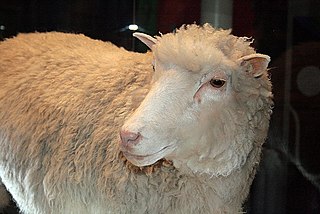
Dolly was a female Finn-Dorset sheep and the first mammal that was cloned from an adult somatic cell. She was cloned by associates of the Roslin Institute in Scotland, using the process of nuclear transfer from a cell taken from a mammary gland. Her cloning proved that a cloned organism could be produced from a mature cell from a specific body part. Contrary to popular belief, she was not the first animal to be cloned.
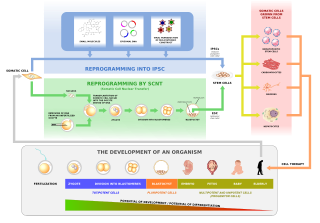
Human cloning is the creation of a genetically identical copy of a human. The term is generally used to refer to artificial human cloning, which is the reproduction of human cells and tissue. It does not refer to the natural conception and delivery of identical twins. The possibilities of human cloning have raised controversies. These ethical concerns have prompted several nations to pass laws regarding human cloning.

In genetics and developmental biology, somatic cell nuclear transfer (SCNT) is a laboratory strategy for creating a viable embryo from a body cell and an egg cell. The technique consists of taking an denucleated oocyte and implanting a donor nucleus from a somatic (body) cell. It is used in both therapeutic and reproductive cloning. In 1996, Dolly the sheep became famous for being the first successful case of the reproductive cloning of a mammal. In January 2018, a team of scientists in Shanghai announced the successful cloning of two female crab-eating macaques from foetal nuclei.

Embryonic stem cells (ESCs) are pluripotent stem cells derived from the inner cell mass of a blastocyst, an early-stage pre-implantation embryo. Human embryos reach the blastocyst stage 4–5 days post fertilization, at which time they consist of 50–150 cells. Isolating the inner cell mass (embryoblast) using immunosurgery results in destruction of the blastocyst, a process which raises ethical issues, including whether or not embryos at the pre-implantation stage have the same moral considerations as embryos in the post-implantation stage of development.

Anthony John Clark OBE FRSE was an English molecular biologist who was a founder of applying molecular technology to farm animals. He was director of the Roslin Institute from 2002 to 2004.
Commercial animal cloning is the cloning of animals for commercial purposes, currently, including livestock, competition camels and horses, pets, medical uses, endangered and extinct animals, as first demonstrated in 1996 for Dolly the sheep.
Sir Ian Wilmut, OBE FRS FMedSci FRSE is an English embryologist and Chair of the Scottish Centre for Regenerative Medicine at the University of Edinburgh. He is best known as the leader of the research group that in 1996 first cloned a mammal from an adult somatic cell, a Finnish Dorset lamb named Dolly. He was appointed OBE in 1999 for services to embryo development and knighted in the 2008 New Year Honours. He together with Keith Campbell and Shinya Yamanaka jointly received the 2008 Shaw Prize for Medicine and Life Sciences "for their works on the cell differentiation in mammals."

Nuclear transfer is a form of cloning. The step involves removing the DNA from an oocyte, and injecting the nucleus which contains the DNA to be cloned. In rare instances, the newly constructed cell will divide normally, replicating the new DNA while remaining in a pluripotent state. If the cloned cells are placed in the uterus of a female mammal, a cloned organism develops to term in rare instances. This is how Dolly the Sheep and many other species were cloned. Cows are commonly cloned to select those that have the best milk production. On 24 January 2018, two monkey clones were reported to have been created with the technique for the first time.
Polly and Molly, two ewes, were the first mammals to have been successfully cloned from an adult somatic cell and to be transgenic animals at the same time. This is not to be confused with Dolly the Sheep, the first animal to be successfully cloned from an adult somatic cell where there wasn’t modification carried out on the adult donor nucleus. Polly and Molly, like Dolly the Sheep, were cloned at the Roslin Institute in Edinburgh, Scotland.
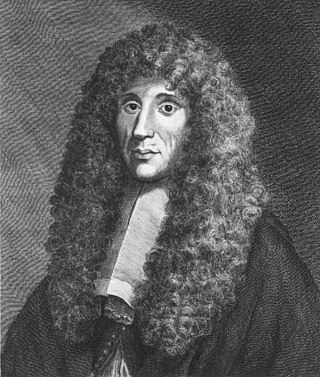
A biologist is a scientist who conducts research in biology. Biologists are interested in studying life on Earth, whether it is an individual cell, a multicellular organism, or a community of interacting populations. They usually specialize in a particular branch of biology and have a specific research focus.
In biology, reprogramming refers to erasure and remodeling of epigenetic marks, such as DNA methylation, during mammalian development or in cell culture. Such control is also often associated with alternative covalent modifications of histones.
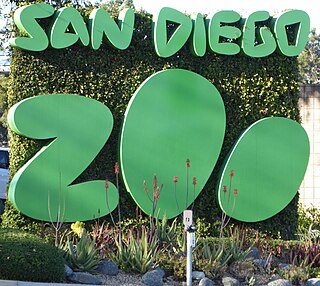
A frozen zoo is a storage facility in which genetic materials taken from animals are stored at very low temperatures (−196 °C) in tanks of liquid nitrogen. Material preserved in this way can be stored indefinitely and used for artificial insemination, in vitro fertilisation, embryo transfer, and cloning. Some facilities also collect and cryopreserve plant material.
Stemagen is a corporation headed by Dr. Samuel Wood, notable for cloning adult skin cells On January, 2008, Dr. Andrew French, Stemagen's chief scientific officer and Wood in California, announced that they successfully created the first 5 mature human embryos using DNA from adult skin cells, aiming to provide a less-controversial source of viable embryonic stem cells. Dr. Wood and a colleague donated skin cells, and DNA from those cells was transferred to human eggs. It is not clear if the embryos produced would have been capable of further development, but Dr. Wood stated that if that were possible, using the technology for reproductive cloning would be both unethical and illegal. The 5 cloned embryos, created in Stemagen Corporation lab, in La Jolla, were later destroyed to confirm the nuclear transfer process.

Keith Henry Stockman Campbell was a British biologist who was a member of the team at Roslin Institute that in 1996 first cloned a mammal, a Finnish Dorset lamb named Dolly, from fully differentiated adult mammary cells. He was Professor of Animal Development at the University of Nottingham. In 2008, he received the Shaw Prize for Medicine and Life Sciences jointly with Ian Wilmut and Shinya Yamanaka for "their works on the cell differentiation in mammals".
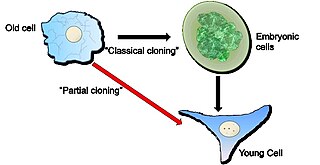
In the field of cell biology, the method of partial cloning (PCL) converts a fully differentiated old somatic cell into a partially reprogrammedyoung cell that retains all the specialised functions of the differentiated old cell but is simply younger. The method of PCL reverses characteristics associated with old cells. For example, old, senescent, cells rejuvenated by PCL are free of highly condensed senescence-associated heterochromatin foci (SAHF) and re-acquire the proliferation potential of young cells. The method of PCL thus rejuvenates old cells without de-differentiation and passage through an embryonic, pluripotent, stage.
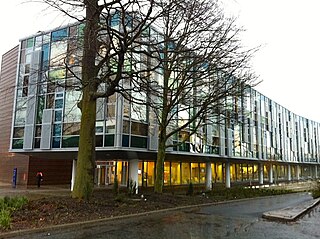
The Roslin Institute is an animal sciences research institute at Easter Bush, Midlothian, Scotland, part of the University of Edinburgh, and is funded by the Biotechnology and Biological Sciences Research Council.

In re Roslin Institute (Edinburgh), 750 F.3d 1333 (Fed. Cir. 2014), is a 2014 decision of the United States Court of Appeals for the Federal Circuit rejecting a patent for a cloned sheep known as "Dolly the Sheep"— the first mammal ever cloned from an adult somatic cell.

Zhong Zhong and Hua Hua are a pair of identical crab-eating macaques that were created through somatic cell nuclear transfer (SCNT), the same cloning technique that produced Dolly the sheep in 1996. They are the first cloned primates produced by this technique. Unlike previous attempts to clone monkeys, the donated nuclei came from fetal cells, not embryonic cells. The primates were born from two independent surrogate pregnancies at the Institute of Neuroscience of the Chinese Academy of Sciences in Shanghai.
Grahame Bulfield, CBE, FRSE, Hon FRASE is an English geneticist, vice-principal and Emeritus Professor of Genetics at the University of Edinburgh. He is best known as the former director and chief executive of the Roslin Institute, Edinburgh, when in 1996 the research group led by Ian Wilmut first cloned a mammal from an adult somatic cell, a Finnish Dorset lamb named Dolly.













